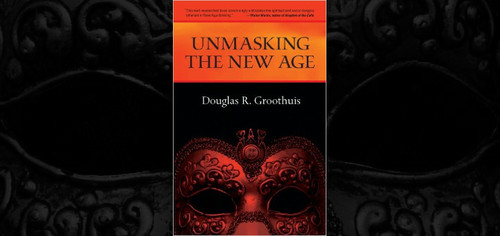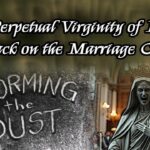Who is Douglas Groothuis?
According to various autobiographical web pages, Doug Groothuis is an “evangelical, protestant, near-Anglican”[1] Christian and a “constructive curmudgeon”[2] On these informal web pages, Groothuis writes with regularity and at some length, with a fire in his bones[3], about Christianity. He is well-qualified to do so. “Groothuis joined the faculty (of Denver Seminary) in 1993 and is the Professor of Philosophy at that institution. He is a member of the Evangelical Theological Society, the Evangelical Philosophical Society, and the Society of Christian Philosophers…Groothuis received a Ph.D. and a B.S. from the University of Oregon, and an M.A. in philosophy from the University of Wisconsin–Madison…He has written for scholarly journals such as Religious Studies, Sophia, Research in Philosophy and Technology, Journal of the Evangelical Theological Society, Philosophia Christi, Trinity Journal, and Asbury Theological Journal as well as for numerous popular magazines”[4] He has written twelve books, of which Unmasking the New Age is the first, having been published in 1986.
The Book’s Purpose: Explaining an Age to Come
The subtitle of the 1986 book Unmasking the New Age asks the question “Is there a new religious movement trying to transform society?” Its author attempted to make the case that there was while attempting to prepare readers to identify and respond to its challenges from a Christian perspective. According to him, “The Western World is faced with a new order, a new world view, a New Age…We are excitedly told that we are more than we imagined and that the world is about to take a leap into the light of expanded consciousness.” (36) By now, of course, the New Age movement is no longer “new”. Unmasking the New Age was written long before some of the spiritual practices and ways of thinking examined in the book became as popular as they today are. For example, Doug Groothuis warned readers to “steer clear of yoga” (68) in the book’s third chapter. This warning came nearly three decades before yoga became a “$27 billion industry with 20 million practitioners.”[5] To put the matter bluntly, the New Age has been unmasked for quite some time. Due to the book’s age, the contemporary reader of Unmasking the New Age must repurpose the work. It is no longer a prophetic warning given to facilitate a proactive Christian apologetic against an emerging occult movement but rather a sort of exposition and history that helps the Christian reader formulate a reactive apologetic to the remaining influence of the New Age movement that was emerging in Western society during the 1980s.
An Exposition of Eastern Ecumenism
The content of Unmasking the New Age was broken down into eight chapters which progressively addressed the ramifications of the New Age movement. In the book’s early chapters, Groothuis explained the spiritual beliefs inherent in New Age thought and examined the subcultures from which New Age influences were emerging. He then explored the effects of New Age ideals upon Western healthcare, psychology, science, politics, and spiritual expression. In the book’s final chapter, Groothuis contrasted Christian thought against that of the New Age, challenging his readers to meet the New Age movement head on with a Christian witness. This was no simple task given that New Age thought, which emerged from Eastern spirituality, is hardly monolithic.
Whereas Western spirituality (which arguably includes the geographically Eastern religious systems of Islam and Judaism) tends to feature authoritative scriptures, principles, clerical bodies, confessions, and creeds, Eastern spirituality tends to be less formalized and somewhat decentralized. Furthermore, the acceptance of contradictory statements as concurrently true is a “much more common and recurrent view in Eastern Philosophy than in the West.”[6] Thus, it is difficult to pin down single doctrines and authorities within the New Age movement, which was described by one of Groothuis’ academic colleagues as “ecumenical” (9), to analyze and refute. Nonetheless, this is the very task that Groothuis set out to perform in writing Unmasking the New Age. To do so, he epitomized New Age thought in a concept that he called “The One for All”. The essential “doctrines” of the “One for All” are the ideas that “All is One” (18), “All is God” (20), “Humanity is God” (21), and “All Religions are One” (27). For the New Age thinker, Jesus Christ isn’t any more God than he himself is. “Jesus of Nazareth…is merely one of many appearances or manifestations of God throughout the millennia.” (28) The mission of the New Age Jesus was to show his fellow men that they were a part of the universal, pantheistic god-consciousness of which existence is constituted. This is not the mission of the Jesus of the Bible. Thus Groothuis argued that New Age spirituality was a rejection of Biblical Christianity.
Additionally, Groothuis argued that the New Age movement was a rejection of an altogether different anti-Christian worldview as well, that of secular humanism. He saw the New Age movement as having emerged from the 1960s counterculture, evolving along with the thinkers who developed out of that milieu. They not only rejected Christianity but also the hopeless nihilism of secular thought. They traded Western Christian and secular humanistic worldviews for an Eastern alternative that opened their minds to different ways of looking at the nature of existence. Health wasn’t confined to anatomy but was holistically extended to energies and life forces. Death became, not an end, but “a transition to another state of consciousness or…an illusion” (64). The influence of New Age thought was apparent to Groothuis in the growing popularity of the physical practices such acupuncture, therapeutic touch, biofeedback, and yoga. Groothuis also saw that mental practices fell under New Age influence, remarking that the New Age sought “personal transformation…to liberate the human mind, to provide a New Consciousness and psychology” (72) through promises of opening up the mind with practices such as ESP.[7]
The New Age, according to Groothuis, was also seeking to influence political affairs by “spiritualizing the left” (112). In 1986, Groothuis saw the educational and political scene as primed for a New Age takeover. In the antepenultimate chapter of Unmasking the New Age, Groothuis wrote that “the growing influence and popularity of pantheism in psychology, science, health care, and religious practices are bound to spill over into the political arena.” (113) Groothuis foresaw a push from the “One for All” crowd for a “new world order where the nations are united politically and economically” (117). He also foresaw a push from the “One For All” crowd to seed religious thought with mysticism and moral relativism. The final chapter of his book straightforwardly addressed the stark differences between the Christian worldview and that of the New Age (and for good measure addressed the difference between those worldviews and secular humanism). Despite these differences, Groothuis observed that “just as the New Age has infiltrated many disciplines with the attractiveness of its views, it has also seduced some Christians…some have assimilated compromised Christianity by assimilating New Age ideas and practices.” (171) He expressly warned Christians to be careful with mystical writings and to avoid the practice of positive confession, ending his book with a call for Christian to do their best to stem the tide of the “One for All”.
An Evaluation: Looking Back on the New Age
Nearly thirty years after Unmasking the New Age was published, it’s clear that political machinations of the New Age didn’t quite pan out. Although the left has obtained significant influence in Western politics over the last decade, it seems more stepped in secular humanism than it does in New Age thought. For example, the left has exerted tremendous influence over American society and the healthcare system through the Patient Protection and Affordable Care Act (commonly called Obamacare). However, Obamacare largely regulates the commerce surrounding the practice of traditional western medicine. In the realm of education, the Common Core initiative of in public schools seems more secular than spiritual. Despite the de-emphasis of American exceptionalism by the country’s current governing administration, the international scene remains divided, especially by the influence of radical Islam. Perhaps the failure of the New Age to take hold in society is best illustrated by Groothuis’s most recent publishing in the realm of Christian apologetics, which is far from as focused on combating New Age thought as it once was.[8] The new world order of the New Age has apparently lost out to the older world order of secular humanism.
Unfortunately, just as Groothuis feared, the New Age has made inroads into religious life, especially that of professing Christians. Jesus Calling, which contains the mystical writings[9] of Sarah Young, has become a “runaway best-seller”[10] for the Christian-themed publisher Thomas Nelson. It has even spawned its own “Jesus Calling” franchise of book products. The mystical practice of contemplative prayer has been endorsed by evangelical ladies’ bible study luminaries Beth Moore[11] and Priscilla Shirer[12]. The immensely popular Bible Miniseries[13] was co-produced by New Age mystic Roma Downey, who holds a Masters degree in Spiritual Psychology from the University of Santa Monica.[14] Joyce Meyer and Joel Osteen are two of the most famous and wealthy “Christian” preachers in the world; both teach a “name it and claim it” message of positive confession.[15] Popular television personality Oprah Winfrey, who arguably garners a religious level of devotion from many American women, helped make the positive confession self-help book, The Secret, a best-seller.[16] Clearly, some of Groothuis most disconcerting fears have been realized.
Looking back over the past three decades, one could reasonably conclude that the New Age failed to transform society because it is, plainly, intellectually and scientifically bereft. Outside of its lingering spiritual influence on undiscerning cultural Christians, it seems to be a fad that has lost its kitsch. Aging baby boomers seem to have figured out that they want real doctors and sensibly scientific educations for their children. Even the popular Eastern practice of Yoga appears to have been commercialized far away from its spiritual roots. However, one could also reasonably conclude that the New Age failed to take stronger root in society because voices such as Doug Groothuis sounded an alarm. Unmasking the New Age put forth a strong and informative Christian witness against a very unbiblical movement. Even today, it is a witness that can still be appreciated.
SELECTED BIBLIOGRAPHY
Denver Seminary. Denver Seminary. http://www.denverseminary.edu/about-us/president-faculty-staff-board/faculty/dr-douglas-r-groothuis/ (accessed February 6, 2014).
Facebook. Douglas Groothuis. https://www.facebook.com/DouglasRichardGroothuis/about (accessed February 6, 2014).
Gregorie, Carolyn. How Yoga Became A $27 Billion Industry — And Reinvented American Spirituality. December 16, 2013. http://www.huffingtonpost.com/2013/12/16/how-the-yoga-industry-los_n_4441767.html (accessed September 6, 2017).
Groothuis, Douglas. Christian Apologetics: A Comprehensive Case for Biblical Faith. Downers Grove, Illinois: Intervarsity Press, USA, 2011.
—. The Constructive Curmudgeon. http://www.theconstructivecurmudgeon.blogspot.com/ (accessed February 6, 2014).
Hill, Aaron. “Touched By A Cult: The Beliefs of Roma Downey.” A Ransomed Mined. March 30, 2015. http://www.aaronhill.org/touched-by-a-cult-the-beliefs-of-roma-downey/ (accessed September 11, 2016).
Kelley, Keith J. “Publisher anticipates high demand for follow-up to ‘Jesus Calling’.” New York Post. May 12, 2016. http://nypost.com/2016/05/12/publisher-anticipates-high-demand-for-follow-up-to-jesus-calling/ (accessed 11 2016, September).
Martin, Tim. “Joyce Meyer.” The Watchman Fellowship Profile Notebook, December 2012.
Silva, Ken. “Apprising Ministries.” Priscilla Shirer and Contemplative/Centering Prayer. July 26, 2010. http://apprising.org/2010/07/26/priscilla-shirer-and-contemplativecentering-prayer/ (accessed September 11, 2016).
Slick, Matt. “Beth Moore.” Christian Apologetics Research Minsitry. https://carm.org/beth-moore (accessed September 11, 2016).
Stanford Encyclopedia of Philosophy. “Dialetheism.” Stanford Encyclopedia of Philosophy. March 28, 2013. http://plato.stanford.edu/entries/dialetheism/ (accessed September 10, 2016).
Walker, James. “The Secret.” The Watchman Fellowship Profile Notebook,, March 2013.
[1] Facebook. Douglas Groothuis. https://www.facebook.com/DouglasRichardGroothuis/about
[2] Groothuis, Douglas. The Constructive Curmudgeon. http://www.theconstructivecurmudgeon.blogspot.com/ (accessed February 6, 2014).
[3] Here, I paraphrase a comment he made during a lecture in New Orleans in January 2014. In this comment, he alluded to Ezekiel 3:14.
[4] Denver Seminary. Denver Seminary. http://www.denverseminary.edu/about-us/president-faculty-staff-board/faculty/dr-douglas-r-groothuis/
[5] Gregorie, Carolyn. How Yoga Became A $27 Billion Industry — And Reinvented American Spirituality. December 16, 2013. http://www.huffingtonpost.com/2013/12/16/how-the-yoga-industry-los_n_4441767.html (accessed September 6, 2017).
[6] Stanford Encyclopedia of Philosophy. “Dialetheism.” Stanford Encyclopedia of Philosophy. March 28, 2013. http://plato.stanford.edu/entries/dialetheism/ (accessed September 10, 2016)
[7] “ESP” is a common acronym for the pseudoscientific concept of Extrasensory Perception.
[8] Groothuis followed up Unmasking the New Age with Confronting the New Age and Revealing the New Age Jesus in 1998 and 1998, respectively. His Magnum opus, Christian Apologetics, published in 2011, is more a more general Christian apologetic and is not specifically focused on the New Age.
[9] Jesus Calling is written in the voice of Jesus Christ and purports to be revelation from him. Young’s method for writing Jesus Calling has been likened to the occult practice of automatic writing.
[10] Kelley, Keith J. “Publisher anticipates high demand for follow-up to ‘Jesus Calling’.” New York Post. May 12, 2016. http://nypost.com/2016/05/12/publisher-anticipates-high-demand-for-follow-up-to-jesus-calling/ (accessed 11 2016, September).
[11] Slick, Matt. “Beth Moore.” Christian Apologetics Research Minsitry. https://carm.org/beth-moore (accessed September 11, 2016).
[12] Silva, Ken. “Apprising Ministries.” Priscilla Shirer and Contemplative/Centering Prayer. July 26, 2010. http://apprising.org/2010/07/26/priscilla-shirer-and-contemplativecentering-prayer/ (accessed September 11, 2016).
[13] and the related Son of God feature film and AD television series
[14] Hill, Aaron. “Touched By A Cult: The Beliefs of Roma Downey.” A Ransomed Mined. March 30, 2015. http://www.aaronhill.org/touched-by-a-cult-the-beliefs-of-roma-downey/ (accessed September 11, 2016).
[15] Martin, Tim. “Joyce Meyer.” The Watchman Fellowship Profile Notebook, December 2012.
[16] Walker, James. “The Secret.” The Watchman Fellowship Profile Notebook,, March 2013.












